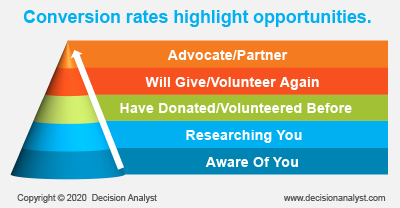Brand-Loyalty Roadmap: It Works for Business and Nonprofits Alike
by Lesley Johnson
-
I love the moisturizer I use. It’s expensive—but it is organic, has the vitamins I want, makes the impact on my skin that I need, is sold in a store where I can easily get more, and is animal cruelty-free.
These are benefits and attributes I value about this product. Each is an important piece of my decision to buy this product, and if any of these attributes changed, I would have to re-evaluate my love for—and my future purchases of—this product.
Both companies and nonprofits derive loyalty by providing benefits beyond just a product or social program at a specific price or donation level. These benefits can be the way a product or organization makes consumers feel, the solution to a problem it champions, the attributes associated with it, or even the cachet of the brand or social cause itself.
These attributes contribute to consumers’ decisions to buy a product or, in the instance of donors and sponsors for a nonprofit organization, on who to partner with, provide volunteers to, or give money to. To maximize success, a nonprofit organization needs to understand its strengths and weaknesses in order to leverage the strengths, improve on weaknesses, and therefore, maximize the opportunities with sponsors and donors.
To reach the brand loyalty “destination” of having a dedicated advocate and partner base, it is imperative that organizations consistently deliver on your mission and exceed expectations. A few research techniques can be applied to evaluate your organization and ensure you’re building the right road to drive loyalty among your donors and sponsors.
Driving Focus
Key-driver analysis uncovers the benefits that are important to current or potential donors/partners—not just those that they say are important, but also those that are less obvious. Going further, importance/performance mapping allows you to measure how well your organization delivers on the most important benefits, which helps narrow the focus of your improvement efforts. Finally, perceptual mapping provides a visual representation of your organization relative to others, including how donors and sponsors view you. This analysis can help you identify how or if your organization is differentiated, as well as help uncover white-space opportunities that your organization could serve.
The results of this work, which would uncover your current position and identify your strengths and weaknesses, would give your organization the tools to build a roadmap that focuses on the attributes and messaging that most align with your strategy and with the expectations and perceptions donors and sponsors have of your organization. Delivering on the strategy mapped by these analyses will help you drive brand-loyalty conversion—moving sponsors and donors from occasional partners to consistent donor-advocate.
Driving Loyalty
-
Once your organization has its roadmap, you are better positioned to meet your donors’ and sponsors’ expectations, and you are on your way to building a foundation for loyalty. In order to drive increases in sponsorships, volunteer engagement, and donations, your efforts may primarily focus on generating name awareness through advertising and marketing. Additional efforts that align with your strategy may be more focused on helping to convert donors from inconsistent commitment (or maybe social media followers) to long-term advocates or partners.
With all this effort put into play, the question then is whether or not it is working to consistently move donors/sponsors along the path to loyalty, converting them from awareness to advocacy. Do people donate but not prefer your organization? Are you their preferred organization, but they fail to provide repeated support? Understanding where conversion is slow or stops by measuring donor/sponsor conversion from step to step on the path can further highlight where to focus.
In Conclusion
As an organization, you may know where your strengths and weaknesses lie, or you may not. You may know what is important to your donors and sponsors, or you may not. If you are not sure, it’s worth conducting some research to understand what matters to your donors and sponsors and how well you deliver on what’s important to them. Only in meeting and exceeding their expectations can you drive loyalty to your organization.
About the Author
Lesley Johnson (ljohnso@decisionanalyst.com) is a Senior Project Director at Decision Analyst. She may be reached at 1-800-262-5974 or 1-817-640-6166.
Copyright © 2020 by Decision Analyst, Inc.
This posting may not be copied, published, or used in any way without written permission of Decision Analyst.




